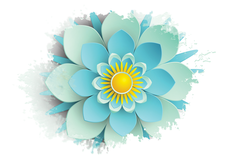Photorealistic images with vector graphics
Visual Math

What are vector graphics and how could we make them better?
Have you ever wondered why you can zoom in on a piece of text in your web browser, PDF viewer, or word processor, and it still retains the smooth look it had at the original scale? In comparison, zooming in on a web image generally yields a pixelated or ragged-looking result. What gives text this resolution-independent property, and is it possible to extend this property to graphics in general?
Understanding Vector Graphics
A discussion of computer graphics should begin with the observation that there are two types of graphics: raster graphics and vector graphics. You're probably quite familiar with raster graphics – rectangular grids composed of individually colored pixels. Zooming in on a pixel-based raster image eventually results in either a blocky picture or a somewhat smoother result that often looks a bit blurred. This blurring or distortion is caused by an interpolation algorithm that generates new pixel data for the magnified version based on the values of neighboring pixels. On the other hand, vector graphics relies on mathematical descriptions of curves. These descriptions are resolution-independent, which means that vector graphics can scale without losing quality. The glyphs of a font that you look at on your screen are examples of vector graphics in daily life. If you're interested in taking a closer look at the curves defining these characters, install FontForge [1] (or alternatively, Birdfont [2]), and open a font you're interested in (commonly stored in /usr/share/fonts).
For a deeper look at vector graphics, it is very useful to install a dedicated vector graphics editor – the open source Inkscape is an excellent choice. Start by adding a circle, a (rounded) star, and a single character from your favorite font. Set the fill of all objects to none and the stroke to a solid light gray. Then, with all three selected, choose the option Path | Object to Path. Viewing the resulting paths in edit mode (F2) with everything selected should yield a result similar to the images in Figure 1.
[...]
Buy this article as PDF
(incl. VAT)
Buy Linux Magazine
Subscribe to our Linux Newsletters
Find Linux and Open Source Jobs
Subscribe to our ADMIN Newsletters
Support Our Work
Linux Magazine content is made possible with support from readers like you. Please consider contributing when you’ve found an article to be beneficial.

News
-
Another Linux Malware Discovered
Russian hackers use Hyper-V to hide malware within Linux virtual machines.
-
TUXEDO Computers Announces a New InfinityBook
TUXEDO Computers is at it again with a new InfinityBook that will meet your professional and gaming needs.
-
SUSE Dives into the Agentic AI Pool
SUSE becomes the first open source company to adopt agentic AI with SUSE Enterprise Linux 16.
-
Linux Now Runs Most Windows Games
The latest data shows that nearly 90 percent of Windows games can be played on Linux.
-
Fedora 43 Has Finally Landed
The Fedora Linux developers have announced their latest release, Fedora 43.
-
KDE Unleashes Plasma 6.5
The Plasma 6.5 desktop environment is now available with new features, improvements, and the usual bug fixes.
-
Xubuntu Site Possibly Hacked
It appears that the Xubuntu site was hacked and briefly served up a malicious ZIP file from its download page.
-
LMDE 7 Now Available
Linux Mint Debian Edition, version 7, has been officially released and is based on upstream Debian.
-
Linux Kernel 6.16 Reaches EOL
Linux kernel 6.16 has reached its end of life, which means you'll need to upgrade to the next stable release, Linux kernel 6.17.
-
Amazon Ditches Android for a Linux-Based OS
Amazon has migrated from Android to the Linux-based Vega OS for its Fire TV.

